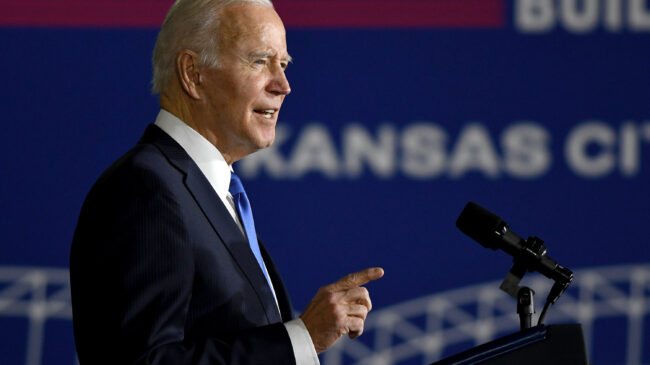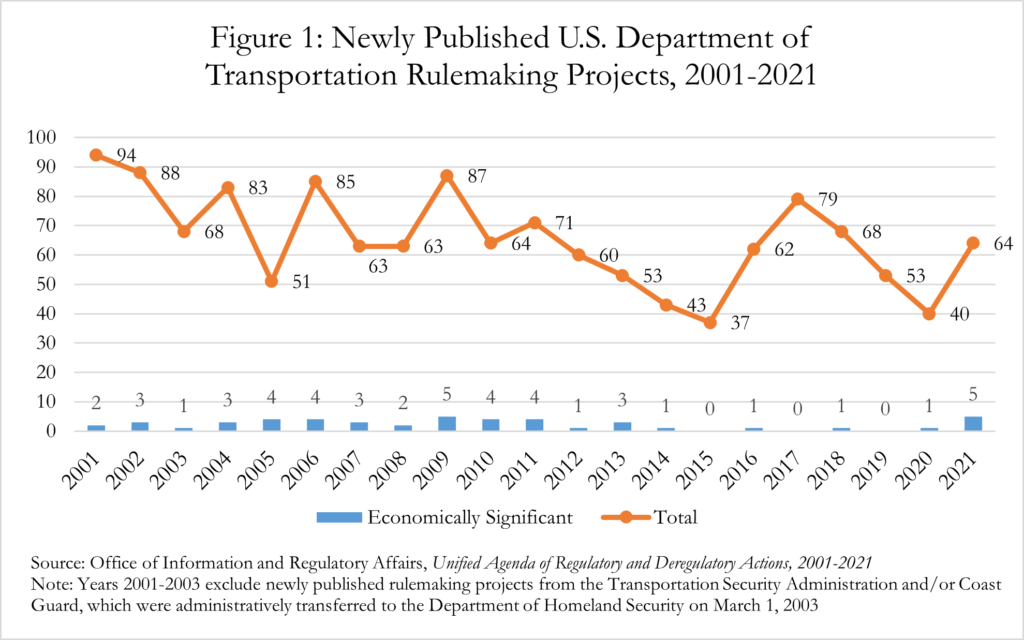As the country ends 2021 facing surging inflation, snarled supply chains, and ongoing public health anxiety, a recent White House report suggests the Department of Transportation plans to ring in the new year with major new regulatory burdens on the transportation sector. Perhaps this was to be expected given the political proclivities of President Joe Biden, but his administration’s transportation regulatory priorities should still concern any supporter of efficient transportation, especially as consumer pain points related to transportation and logistics are already inflamed and are likely to be further aggravated by Secretary of Transportation Pete Buttigieg’s policies.
Twice a year in the spring and fall, the Office of Information and Regulatory Affairs, a small office within the White House’s Office of Management and Budget, releases the Unified Agenda of Regulatory and Deregulatory Actions. This report provides a summary snapshot of the regulations being advanced by the hundreds of federal executive branch agencies.
The Fall 2021 Unified Agenda was released on Dec. 10, closing out the first full year of the Biden administration and allowing us to begin to make historical regulatory activity comparisons. Table 1 at the end of this article lists the Department of Transportation’s 37 rulemaking projects first published in the Fall 2021 Unified Agenda. Figure 1 below shows the flow of new rulemaking projects at the Department of Transportation from 2001-2021.
Rulemaking at the Department of Transportation (DOT) during the first year of the Biden administration doesn’t appear out of the ordinary. The 64 newly published rulemaking projects in Fall 2021 are the median over the last two decades. However, the more concerning number is the five “economically significant” rulemaking projects initiated in 2021.
Economically significant regulations are defined by Executive Order 12866 as rules that produce “an annual effect on the economy of $100 million or more or adversely affect in a material way the economy, a sector of the economy, productivity, competition, jobs, the environment, public health or safety, or State, local, or tribal governments or communities.” This ties the 21st century’s economically significant rule record set by the Obama administration’s Department of Transportation in 2009. For reference, the 2001-2021 median is two new economically significant rulemaking projects per year.
It must be noted that these annual rulemaking activity comparisons do not allow us to make broad claims about regulatory burden, because adding a new regulatory burden uses the same process as eliminating an existing regulatory burden, and these are process-based statistics. Further, whether or not a rule is economically significant is often determined after it is first published in the Uniform Agenda. So, using figures based on the first publication undercounts the number of economically significant rules in the administrative pipeline.
However, four of the five rulemaking projects deemed economically significant that were initiated in 2021 by the Biden administration’s Department of Transportation are expected to increase, rather than reduce, the regulatory burden. They are:
- Federal Aviation Administration (FAA), “Promoting Aviation Regulations for Technical Training” (RIN: 2120-AL67): In the FY 2021 omnibus appropriations law, Congress required FAA to modernize Part 147 aviation maintenance technician school certification, the first overhaul of these rules since 1962 (Section 135). The Aviation Technician Education Council has a helpful summary. This rulemaking was explicitly required by Congress, rather than being a discretionary choice made by the Biden administration, and is the only rule of the five economically significant rulemaking projects first published in 2021 that would reduce the burden on regulated entities. Congress ordered FAA to publish this interim final rule by March 2021. In the Spring 2021 Unified Agenda, FAA indicated it planned for a November 2021 publication. The latest Fall 2021 Unified Agenda indicates FAA plans to publish the rule in May 2022.
- National Highway Traffic Safety Administration (NHTSA), “Passenger Car and Light Truck Corporate Average Fuel Economy Standards” (RIN: 2127-AM34): This rule would rescind the Trump administration’s Corporate Average Fuel Economy amendments—the Safer Affordable Fuel-Efficient (SAFE) Vehicles Rule—and replace them with more stringent fuel economy mandates. This rule is anticipated to substantially increase the burden on regulated entities and increase automobile prices for consumers. This is a top regulatory priority of the Biden administration. The notice of proposed rulemaking was published in September 2021 and the Fall 2021 Unified Agenda indicates the final rule is anticipated in March 2022.
- NHTSA, “Heavy Vehicle Automatic Emergency Braking” (RIN: 2127-AM36): This rule would potentially mandate—and at the very least standardize performance when equipped—forward collision warning and automatic emergency braking systems on heavy trucks. In 2015, the National Highway Traffic Safety Administration granted a petition from four advocacy groups to open this rulemaking, but it stalled during the Trump administration due to concerns over prematurely mandating novel technology with a thin safety record and the added burden on regulated entities. The Fall 2021 Unified Agenda indicates NHTSA anticipates publishing a notice of proposed rulemaking in April 2022.
- NHTSA, “Light Vehicle Automatic Emergency Braking (AEB) with Pedestrian AEB” (RIN: 2127-AM37): This is similar to the heavy truck automatic emergency braking rule but for light vehicles. The rule would mandate, by some date in the future, that all newly manufactured light-duty vehicles be equipped with automatic emergency braking, including systems designed to detect and protect pedestrians. Concerns over technological readiness and the added burden on regulated entities—and increased automobile prices faced by consumers—deterred previous administrations from proceeding with this rulemaking. The Fall 2021 Unified Agenda indicates the notice of proposed rulemaking is anticipated in April 2022.
- NHTSA, “Fuel Efficiency and Greenhouse Gas Standards for Medium- and Heavy-Duty Engines and Vehicles” (RIN: 2127-AM39): This rule aims to support the creation of new greenhouse gas and fuel efficiency standards on medium- and heavy-duty trucks, vans, and buses, and is anticipated to increase the burden on regulated entities. The Spring 2021 Unified Agenda estimated an April 2022 publication, but the Fall 2021 Unified Agenda indicates NHTSA anticipates publishing a notice of proposed rulemaking in September 2022.
But it isn’t just rules already deemed economically significant that are concerning. For example, the Department of Transportation’s Statement of Regulatory Priorities, part of the Biden administration’s first annual Regulatory Plan published in Fall 2021, mentions, “FRA’s regulatory priority for Fiscal Year 2022 is to propose regulations addressing the issue of the requirements for safe minimum train crew size depending on the type of operation.”
This refers to a rulemaking project to revive a proposal from the Obama administration to mandate a minimum freight train crew size of two, which was subsequently withdrawn by the Trump administration. Supporters of the change claim it is for safety reasons. However, as the Obama-era Federal Railroad Administration (FRA) learned, there is no statistical evidence to support the claim that two-person crews are safer than one-person crews. (It is worth noting that one-person freight train crews have long been the norm in European peer countries.) When the Obama FRA falsely claimed such evidence existed in a draft submitted for review to the White House’s Office of Information and Regulatory Affairs (OIRA), it earned a strong rebuke from OIRA and was forced to concede as much in its March 2016 notice of proposed rulemaking. The forced admission by the Obama-era Federal Railroad Administration that it had no evidence supporting its crew-size position led the Trump administration’s FRA to withdraw the proposed rule in May 2019.
In reality, safety is a cover for the actual dispute over the breadth of collective bargaining negotiations between railroads and the unions representing their employees. This was highlighted in a Texas federal court that in February 2020 ruled in favor of railroads that a union must negotiate on crew sizes. From the perspective of the unions, narrowing the scope of collective bargaining by having the government mandate favorable terms makes sense. But a safety regulator should not be unlawfully working backward to develop a regulatory justification for a union’s self-interested position, as the Obama FRA did and as the Biden FRA appears to be doing.
As part of its May 2019 withdrawal, the Federal Railroad Administration stated it intended to preempt state crew-size laws, which railway labor unions have been promoting in recent years while the federal situation remained uncertain. Two unions and the states of California, Nevada, and Washington challenged FRA’s order on procedural grounds and scored a victory when a federal appeals court in California vacated FRA’s 2019 withdrawal and preemption order in February 2021.
Under federal law, FRA has broad authority to set minimum national railroad safety requirements and preempt states that deviate from its regulations (49 U.S.C. § 20106). Given that no safety evidence exists to support a two-person crew-size minimum rule, if Federal Railroad Administration Acting Administrator Amit Bose is indeed interested in promoting uniform federal policy on this question—as he told senators at his September 2021 confirmation hearing—the proper response to the appeals court’s Feb. 2021 decision is to address the identified procedural deficiencies and re-propose a similar withdrawal and preemption rule.
But given the Biden administration’s close ties to organized labor and promises President Biden made on the campaign trail, it is much more likely that FRA will re-propose something similar to the discredited Obama FRA proposed rule, which would then be challenged by railroads as unlawful.
This approach is unfortunate because future crew-size reductions and associated labor cost savings are critical to ensuring U.S. freight railroads invest in automation technologies that are needed to compete in a future of automated trucks, as I discuss at length in a September 2021 paper published by Reason Foundation. And this doesn’t just apply to train operations. Infrastructure inspection automation is also critical to the future success of U.S. freight rail and the Biden FRA under Acting Administrator Amit Bose has shown itself hostile to those safety-enhancing technologies due to union opposition.
It also highlights a glaring counterexample to President Biden’s professed commitments to a greener future. If the Biden administration is serious about reducing the environmental footprint of the transportation sector, then it is bizarre and contradictory to undercut freight rail facing ever-tougher truck competitors.
As I note in my recent Reason paper, “When compared to freight rail on a ton-miles basis, the U.S. Environmental Protection Agency estimates that trucks emit approximately 10 times as much carbon dioxide (CO2), two-and-a-half times as much nitrogen oxides (NOX), and more than three times as much fine particulate matter (PM2.5).”
Environmental interest groups are currently asleep at the switch on this issue, but the Biden administration should assume that they will eventually wake up and call out the administration’s anti-rail policy positions.
The Biden administration has made many lofty promises on transportation regulatory policy. Unfortunately, none of them would materially improve the short-run operations of U.S. transportation networks that face unprecedented challenges, and many are likely to raise costs and degrade performance over the long-run. As the regulatory apparatus at the Department of Transportation kicks into high gear in 2022, Congress should prepare to conduct vigorous oversight.
Rulemaking projects first published in the Fall 2021 Unified Agenda are listed in Table 1. Rulemaking projects that were first published in the Spring 2021 Unified Agenda are listed in Table 1 at the end of this June 2021 article.
Table 1: U.S. Department of Transportation Rulemaking Projects First Published in the Fall 2021 Unified Agenda
| Agency | Stage of Rulemaking | Title | RIN |
| OST | Proposed Rule Stage | Transportation for Individuals with Disabilities; Adoption of Accessibility Standards for Pedestrian Facilities in the Public Right-of-Way | 2105-AF05 |
| OST | Proposed Rule Stage | Transportation for Individuals With Disabilities; Adoption of Accessibility Standards for Buses and Vans | 2105-AF09 |
| OST | Proposed Rule Stage | Enhancing Transparency of Airline Ancillary Service Fees | 2105-AF10 |
| OST | Final Rule Stage | Revisions to Cross References in the Requirements for Federal Awards | 2105-AF06 |
| OST | Final Rule Stage | Civil Monetary Penalties 2022 Inflation Adjustment | 2105-AF11 |
| FAA | Proposed Rule Stage | Revise Airplane Definition to Incorporate Powered-lift Operations | 2120-AL72 |
| FAA | Final Rule Stage | Inclusion of Additional Automatic Dependent Surveillance-Broadcast (ADS-B) Out Technical Standard Order (TSO) | 2120-AL70 |
| FAA | Final Rule Stage | Prohibition Against Certain Flights in the Kabul Flight Information Region (FIR) (OAKX) | 2120-AL71 |
| FHWA | Proposed Rule Stage | Update of 23 CFR Part 630, Subparts A and G | 2125-AG03 |
| FHWA | Proposed Rule Stage | Work Zones | 2125-AG05 |
| FHWA | Proposed Rule Stage | National Performance Management Measures | 2125-AG06 |
| FHWA | Proposed Rule Stage | Highway Safety Improvement Program (HSIP) | 2125-AG07 |
| FHWA | Proposed Rule Stage | Incorporating Safety Into Federal-aid Programs and Projects | 2125-AG08 |
| FHWA | Final Rule Stage | Repeal of 23 CFR 1.28 (Diversion of Highway Revenues) | 2125-AG04 |
| FMCSA | Prerule Stage | Automatic Emergency Braking Systems | 2126-AC49 |
| FMCSA | Prerule Stage | Electronic Logging Device (ELD) Revisions | 2126-AC50 |
| FMCSA | Prerule Stage | Safety Fitness Procedures | 2126-AC52 |
| FMCSA | Prerule Stage | Unique Electronic Identification of Commercial Motor Vehicles | 2126-AC54 |
| FMCSA | Proposed Rule Stage | Amendments to the Commercial Driver’s License (CDL) Requirements; Increased Flexibility for Testing and for Drivers After Passing the Skills Test | 2126-AC46 |
| FMCSA | Proposed Rule Stage | Incorporation by Reference; North American Standard Out-of-Service Criteria; Hazardous Materials Safety Permits | 2126-AC48 |
| FMCSA | Proposed Rule Stage | Fees for the Unified Carrier Registration Plan and Agreement | 2126-AC51 |
| FMCSA | Proposed Rule Stage | Clarification to the Applicability of Emergency Exemptions | 2126-AC53 |
| FMCSA | Final Rule Stage | General Technical Amendments | 2126-AC47 |
| NHTSA | Proposed Rule Stage | Federal Standards for Hydrogen and Fuel Cell Vehicles | 2127-AM40 |
| NHTSA | Proposed Rule Stage | Upgrade FMVSS No. 218, Motorcycle Helmets | 2127-AM42 |
| NHTSA | Proposed Rule Stage | Updates to FMVSS No. 305, Electric-powered Vehicles; Electrolyte Spillage and Electrical Shock Protection | 2127-AM43 |
| NHTSA | Proposed Rule Stage | Update to FMVSS No. 209, Seat Belt Assemblies | 2127-AM44 |
| NHTSA | Final Rule Stage | Final Listing of High-Theft Light Duty Truck and Exempted Lines for MY 2020 | 2127-AM41 |
| FRA | Proposed Rule Stage | Passenger Equipment Safety Standards; Standards for High-Speed Trainsets | 2130-AC90 |
| FTA | Proposed Rule Stage | Charter Service | 2132-AB38 |
| FTA | Proposed Rule Stage | Bus Testing | 2132-AB40 |
| FTA | Final Rule Stage | Rescinding 49 CFR Part 659, Rail Fixed Guideway Systems; State Safety Oversight | 2132-AB39 |
| SLSDC | Proposed Rule Stage | Seaway Regulations and Rules: Periodic Update, Various Categories | 2135-AA51 |
| SLSDC | Proposed Rule Stage | Tariff of Tolls | 2135-AA52 |
| PHMSA | Proposed Rule Stage | Hazardous Materials: Harmonization with International Standards | 2137-AF57 |
| PHMSA | Final Rule Stage | Hazardous Materials: Editorial Corrections and Clarifications | 2137-AF56 |
| PHMSA | Final Rule Stage | Direct Criminal Referrals to Department of Transportation Office of Inspector General | 2137-AF58 |
Note: RIN = Regulation Identifier Number, a unique alphanumeric code assigned by the Regulatory Information Service Center to each rulemaking project listed in the Unified Agenda. An explanation of Stage of Rulemaking terms can be found on page 8 of the Introduction to the Unified Agenda from the Regulatory Information Service Center.


